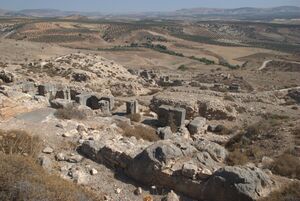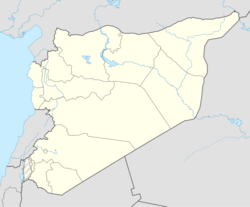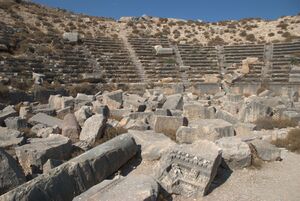النبي هوري
 منظر النبي هوري. | |
| المكان | منطقة عفرين، محافظة حلب، سوريا |
|---|---|
| الإحداثيات | 36°44′39″N 36°57′33″E / 36.74417°N 36.95917°E |
| النوع | Settlement |
| التاريخ | |
| الباني | Seleucus I Nicator |
| تأسس | 300 BC |
| ملاحظات حول الموقع | |
| الحالة | In ruins |
النبي هوري (Cyrrhus ؛ /ˈsɪrəs/; باليونانية: Κύρρος Kyrrhos) هي مدينة في سوريا القديمة أسسها سلوقس المخلص، أحد قادة الإسكندر الأكبر. الأسماء الأخرى للمدينة تضم Hagioupolis و خوروس Ḳūrus. وثمة أصل كاذب للاسم يعود للقرن السادس، يربطها بقورش، ملك فارس بسبب تشابه الاسمين. الأسقفية/المطرانية الرومانية/البيزنطية السابقة هي الآن كرسي رسولي كاثوليكي مزدوج.
موقع سياحي وتاريخي في منطقة عفرين شمالي سوريا، يوجد في الموقع قلعة النبي هوري، وتنتشر الآثار في الموقع الذي يعود لعصور تاريخية قديمة، أما سبب التسمية فيعود إلى وجود دير قدم في المنطقة يقال أن أحد الرجال الصالحين (حوري) أقام فيه وتحول الاسم إلى هوري، وتاريخيا بعد ذلك أصبح المكان مركزا أساسيا لاستراحة القوافل التجارية في هذه المنطقة في سورية.
الموقع
تقع أطلال النبي هوري في منطقة عفرين بشمال سوريا، بالقرب من الحدود التركية.
It lies about 70 km northwest of Aleppo and 24 km west of Killis, in Turkey. Cyrrhus was the capital of the extensive district of Cyrrhestica, between the plain of Antioch and Commagene.
The site of the city is marked by the ruins at Khoros, 20 km from Azaz, Syria, standing near the Afrin Marsyas River, a tributary of the Orontes, which had been banked up by Bishop Theodoret.
التاريخ
The Cyrrhus in Syria was founded by Seleucus Nicator shortly after 300 BC, and was named after the Macedonian city of Cyrrhus. Andronicus of Cyrrhus built the Tower of the Winds in Athens. It was taken by the Armenian Empire in the 1st century BC, then became Roman when Pompey took Syria in 64 BC. By the 1st century AD, it had become a Roman administrative, military, and commercial center on the trade route between Antioch and the Euphrates River crossing at Zeugma, and minted its own coinage.[1] It was the base of the Roman legion Legio X Fretensis.[2] The Sassanid Persian Empire took it several times during the 3rd century.[3]
In the 6th century, the city was embellished and fortified by Byzantine Emperor Justinian. It was however taken by the Muslims in 637 and known at that time under the name of Qorosh and later by the Crusaders in the 11th century. Nur ad-Din Zangi recaptured it in 1150. Muslim travelers of the 13th and 14th century report it both as a large city and as largely in ruins.[4]
الآثار
The city has been excavated by the Lebanese Syrian Archaeological Mission of Cyrrhus.[5] Initial results indicate a square layout with Hippodamian grid road plan and a central main road with Colonnades typical of the Hellenistic east . The road layout seems to have survived until into the Islamic times. Remains in Cyrrhus include two Roman Bridge s in working order, a dilapidated theatre outside the town and foundations of a Basilica church and some city fortifications. In the 6th century a Byzantine citadel was built on the top of the hill behind the theatre.[6] with evidence of Greek and Egyptian influences in the design work.[7] [8] This citadel is still largely unexcavated. Temple of Zeus: The exact date of the city's construction is unknown, as it is attributed to the period of the reign of Seleucus Nicator (312 - 280) BC. Given the importance of the city's location, large military forces were stationed there whose subordination to a city is unknown, and perhaps it was independent of itself. Coins were minted during this period and it was also an important center for the worship of the two gods, Athena, the protector of the great land, and Zeus (the god of the thunderbolt). It is believed that the temple of Zeus stood on top of the mountain next to the city. Syros became a frontier city after the separation of Asia Minor from the Seleucid state, following the Treaty of Apamea in 188 BC, which lost its civilian importance and became a center for assembling armies and securing the strong soldiers of the kings of Antioch. In the year 83 BC, controlled by the king of Armenia (Tikran) the Great, chaos spread in its area, until the Romans recaptured it in the year 69 BC.
التاريخ الكنسي
Cyrrhus became a Christian bishopric at an early date, a suffragan of Hierapolis Bambyce, capital and metropolitan see of the Roman province of Euphratensis. Under Justinian, it became an autocephalous ecclesiastical metropolis subject directly to the Patriarch of Antioch but without suffragans. Its bishop Syricius was present at the First Council of Nicaea in 325. The Arian Abgar (Latinized as Abgarus or Augarus) was at the Council of Seleucia (360). Theodoret mentions as another Arian a bishop called Asterius of the time of the Roman Emperor Valens (364–378). Isidorus attended the First Council of Constantinople in 381. The most celebrated of the bishops of Cyrrhus is Theodoret himself (423-458), a prolific writer,[9] well known for his rôle in the history of Nestorianism, Eutychianism, and Marcionism. He tells us that his small diocese (about forty miles square) contained 800 churches, which supposes a very dense population. In 476, a bishop named Ioannes held a synod against Peter the Fuller. At the close of that century the bishop was a Nestorian named Sergius, who was replaced by another of the same name who was of the directly opposite theological opinion, being a Jacobite, and was deposed by Emperor Justin I in 518. Michael the Syrian lists 13 other Jacobite bishops of the see.[10][11][12]
A magnificent basilica held the relics of Saints Cosmas and Damian, who had suffered martyrdom in the vicinity about 283, and whose bodies had been transported to the city, whence it was also called Hagioupolis. Many holy personages, moreover, chiefly hermits, had been or were then living in this territory, among them Saints Acepsimas, Zeumatius, Zebinas, Polychronius, Maron (the patron of the Maronite Church), Eusebius, Thalassius, Maris, James the Wonder-worker, and others. Bishop Theodoret devoted an entire work to the illustration of their virtues and miracles.[13]
الأساقفة والمطارنة المقيمون Residential (Arch)Bishops of Cyrrhus
| Name | Dates | Churchmanship | Notes | الصورة |
|---|---|---|---|---|
| Syricius | 325 | في مجمع نيقيا الأول | ||
| Abgar | 360 | أريوسي | في مجمع سلوقيا (360) | |
| Asterius | 364–378 | أريوسي | ||
| Isidorus[14][15][16] | 381 | في مجمع القسطنطينية الأول | ||
| Theodoret of Cyrrhus | 423-458 | |||
| Ioannes | 476 | held a synod against Peter the Fuller | ||
| Sergius I of Cyrrhus | late 5th century[17] | Nestorian | was deposed by Byzantine Emperor Justin I | |
| Sergius II of Cyrrhus.[18] | 518 | Jacobite | exiled about AD 522.[19] | |
| John of Cyrrhus[20] | c628 | Orthodox??? | ||
| 12 Jacobite Bishops | ||||
| John of Cyrrhus[20] |
The city was taken in the early 11th century by the Crusaders who made new Bishopric, dependent on Edessa under the name Coricié.
الكرسي الرسولي
No longer a residential bishopric, Cyrrhus is today listed by the Catholic Church as a titular see,[21] in two different rite-specific traditions, in the apostolic succession of the Byzantine archdiocese.
أساقفة كوريسييه الصليبية
الكرسي الرسولي اللاتيني
Established no later then as Titular archbishopric of Cyrrhus (Latin) / Cirro (Curiate Italian) / Cyrrhen(sis) (Latin adjective), alias Cyrrhus of the Latins
It has been vacant for decades, having had the following incumbents, of the fitting Archepiscopal rank with an Episcopal (lowest) exception:
- Carolus Polodig, Teresian Carmelites (O.C.D.) (1713.12.23 – death 1714.07.07), no actual prelature
- Titular Bishop: John Wallace (1720.04.30 – death 1733.06.30) (born Scotland, UK), Coadjutor Apostolic Vicar of Scotland (Scotland) (1720.04.30 – 1727.07.23), Coadjutor Apostolic Vicar of Lowland District of Scotland (Scotland) (1727.07.23 – 1733.06.30)
- Ignazio Nasalli-Ratti (Italian), (1819.12.17 – 1827.06.25), later Cardinal-Priest of S. Agnese fuori le mura (1827.09.17 – death 1831.12.02)
- Luca de Cigalla (1832.07.27 – 1847.02.12), first while Bishop of Santorini (insular Greece) (1828.12.15 – 1847.02.12 ?not possessed), then as Coadjutor Apostolic Vicar of Constantinopole (Ottoman Turkey) (1832.07.27 – 1847.02.12 not possessed)
- Loudovico of St. Teresa Martini, O.C.D. (Italian) (1845.09.30 – death 1883.07.12) while Apostolic Vicar of Verapoly (British India) (1844.12.07 – 1855.11.10) and as emeritus; previously Titular Bishop of Europus (1839.06.07 – 1845.09.30) as Coadjutor Vicar Apostolic of Verapoly (1839.06.07 – succession 1844.12.07)
- Nikolaus Adames (1883.11.02 – death 1887.02.13) as emeritus: previously Titular Bishop of Halicarnassus (1863.03.27 – 1870.09.27 as Pro-Vicar Apostolic of Luxembourg (native Luxembourg) (1848.05.07 – 1863.03.27) and (promoted) last Vicar Apostolic of Luxembourg (Luxembourg) (1863.03.27 – 1870.09.27); next (see promoted) first Bishop of Luxembourg (1870.09.27 – retired 1883.09.27)
- Louis-André Navarre, Sacred Heart Missionaries (M.S.C.) (born France) (1888.08.17 – death 1912.01.17) first as Apostolic Vicar of Melanesia (insular Papua New Guinea) (1887.05.17 – 1889.05.10), then as Apostolic Vicar of New Guinea (mainland Papua New Guinea) (1889.05.10 – 1908.01) and as emeritus; previously Titular Bishop of Pentacomia (1887.05.17 – 1888.08.17)
- Ludovít Szmrecsányi (1912.03.26 – 1912.08.20) (born Slovakia) as Coadjutor Archbishop of Archdiocese of Eger (Hungary) (1912.03.26 – succession 1912.08.20); previously Titular Bishop of Magyddus (1904.11.14 – 1912.03.26) without actual prelature; later Metropolitan Archbishop of above Eger (1912.08.20 –death 1943.01.28)
- BIOs to ELABORATE
- Joaquim José Vieira (1912.11.08 – 1917.07.08)
- Vilmos Batthyány (1920.12.16 – 1923.11.24)
- Serafino Cimino, Friars Minor (O.F.M.) (1924.12.18 – 1928.05.04)
- Gennaro Cosenza (1930.01.02 – 1930.03.20)
- Archbishop-elect Giuseppe Pizzardo (1930.03.28 – 1930.04.22) (later Cardinal)
- Ferdinando Fiandaca (1930.08.01 – 1941.02.18)
- Juan José Aníbal Mena Porta (1941.06.14 – 1949.02.25)
- Silvestro Patrizio Mulligan, Capuchin Franciscans (O.F.M. Cap.) (1950.08.16 – 1950.10.23)
- Eris Norman Michael O’Brien (1951.01.11 – 1953.11.16)
- Guilford Clyde Young (1954.10.10 – 1955.09.20)
- Louis Ferrand (1956.04.17 – 1956.10.28)
- Mário de Miranda Villas-Boas (1956.10.23 – 1959.06.20)
- José Rafael Pulido Méndez (1961.01.16 – 1966.11.22)
كرسي القاصد الرسولي الماروني
No later than 1896 was established the Antiochene rite Titular archbishopric of Cyrrhus / Cirro (Curiate Italian) / Cyrrhen(sis) Maronitarum (Latin adjective), alias Cyrrhus of the Maronites.
In 1956 it was suppressed, having had only these incumbents, both of the fitting Archiepiscopal (intermediate) rank and without actual prelature :
- Joseph Estefan (1896.09.24 – death 1915.07.04)
- Elia Scedid (1926.06.21 – death 1950.01.18) (born Lebanon).
معرض
- NebiHuriSouthGate.jpg
South Gate
- NebiHuriMausoleum.jpg
Mausoleum
References
- ^ Encyclopædia Britannica, 11th ed, s.v. numismatics
- ^ Dow, Joseph A., Ancient Coins Through the Bible, p. 67.
- ^ Ivan Mannheim, Syria and Lebanon Handbook: The Travel Guide, Footprint, 2001. ISBN 978-1-900949-90-3.
- ^ Guy Le Strange, Palestine Under the Moslems: A Description of Syria and the Holy Land from A.D. 650 to 1500, London, 1890.
- ^ First results on the city planning of Cyrrhus (Syria) Abdul Massih, Benech, Gelin ArcheoSciences,revue d’archéométrie, suppl. 33, 2009, p. 201-203.
- ^ Cyrrhus.
- ^ Cyrrhus at Livis.org.
- ^ Richard Stillwell, William L. MacDonald, Marian Holland McAllister, Stillwell, Richard, MacDonald, William L., McAlister, Marian Holland KYRRHOS Syria. in The Princeton Encyclopedia of Classical Sites]
- ^ His works are in Jacques Paul Migne (ed.), Patrologia Graeca, LXXX-LXXXIV.
- ^ Raymond Janin, v. Cyrrhus in Dictionnaire d'Histoire et de Géographie ecclésiastiques, vol. XIII, Paris 1956, coll. 1186-1187
- ^ Michel Lequien, Oriens christianus in quatuor Patriarchatus digestus, Paris 1740, Vol. II, coll. 929-934
- ^ Franz Cumont, Etudes syriennes, Paris 1917, pp. 221 ff.
- ^ Siméon Vailhé, "Cyrrhus" in Catholic Encyclopedia (New York 1908)]
- ^ Raymond Janin, v. Cyrrhus in Dictionnaire d'Histoire et de Géographie ecclésiastiques, vol. XIII, Paris 1956, coll. 1186-1187.
- ^ Michel Lequien, Oriens christianus in quatuor Patriarchatus digestus, Paris 1740, Vol. II, coll. 929-934.
- ^ Ian George Tompkins , PROBLEMS OF DATING AND PERTINENCE IN SOME LETTERS OF THEODORET OF CYRRHUS, Byzantion Vol. 65, No. 1 (1995), pp.176-195.
- ^ Raymond Janin, v. Cyrrhus in Dictionnaire d'Histoire et de Géographie ecclésiastiques, vol. XIII, Paris 1956, coll. 1186-1187
- ^ The Chronicle of Michael the Great, Patriarch of the Syrians 89.
- ^ The Chronicle of Michael the Great, Patriarch of the Syrians 89.
- ^ أ ب The Chronicle of Michael the Great, Patriarch of the Syrians 122.
- ^ Annuario Pontificio 2013 (Libreria Editrice Vaticana 2013 ISBN 978-88-209-9070-1), p. 870
المصادر والوصلات الخارجية
 هذه المقالة تضم نصاً من مطبوعة هي الآن مشاع: هربرمان, تشارلز, ed. (1913). الموسوعة الكاثوليكية. Robert Appleton Company.
هذه المقالة تضم نصاً من مطبوعة هي الآن مشاع: هربرمان, تشارلز, ed. (1913). الموسوعة الكاثوليكية. Robert Appleton Company. {{cite encyclopedia}}: Cite has empty unknown parameters:|1=,|coauthors=, and|month=(help); Invalid|ref=harv(help); Missing or empty|title=(help)- GCatholic - Latin titular see
- GCatholic - Maronite titular see
- Archeological excavations at Cyrrhus/Nebi Houri
- Cyrrhus at livius.org
- Cyrrhus/Nabi Huri at cometosyria.com
Further reading
- Abdul Massih J., 2008, Edmond Frézouls à Cyrrhus : les débuts de la recherche archéologique en Syrie, Document d’Archéologie Syrienne XIV, pp. 424–428.
- Abdul Massih J., 2008, Edmond Frézouls et les publications archéologiques syriennes, Document d’Archéologie Syrienne XIV, pp. 428–430.
- Abdul Massih J., 2006-2007, évaluation de l’état général du site archéologique de Cyrrhus – Nebi Houri Annales Archéologiques de Syrie, XLIX-L, p. 45-59.
- ALPI F., 2011, Base de statue de Justinien ornée d’une inscription métrique (Cyrrhus, Euphratésie), Syria 88, p. 341-349.
- Abdul Massih J, Gelin M., 2009, Notes préliminaires sur l’étude du système défensif méridional de Cyrrhus, Campagnes 2007-2008, Chroniques 2008, Damas 2010, pp. 109–218
- Abdul Massih J., 2009, Urbanisme du site de Cyrrhus : origine et évolution ; Etat de la question, Colloque de damas 2008 sur l’urbanisme en Orient
- Jeanine Abdul Massih, Notes préliminaires sur l’étude du système défensif méridional de Cyrrhus, Campagnes 2007-2008, Chroniques 2008, Damas 2010, pp. 109–218, Damas 2010, pp. 109–218.
- Jeanine Abdul Massih, Les mosaïques de la maison romaine et la fortification polygonale de Cyrrhus (Nebi Houri), Notes préliminaires, Syria 2009, pp. 289–306.
- Ivan Mannheim, Syria and Lebanon Handbook: The Travel Guide, Footprint, 2001. ISBN 978-1-900949-90-3.
- Guy Le Strange, Palestine Under the Moslems: A Description of Syria and the Holy Land from A.D. 650 to 1500, London, 1890.
| هذه بذرة مقالة عن موقع أثري أو تاريخي سوري تحتاج للنمو والتحسين، فساهم في إثرائها بالمشاركة في تحريرها. |
| بوابة سوريا تصـفح مقـالات المعرفة المهـتمة بسوريا. |
- Pages using gadget WikiMiniAtlas
- Short description is different from Wikidata
- Articles with hatnote templates targeting a nonexistent page
- Missing redirects
- Coordinates on Wikidata
- Articles containing Greek-language text
- CS1 errors: missing title
- Articles incorporating text from the 1913 Catholic Encyclopedia with no article parameter
- Hellenistic sites in Syria
- Former populated places in Syria
- Archaeological sites in Aleppo Governorate
- Seleucid colonies
- مواقع أثرية في سوريا
- محافظة إدلب



